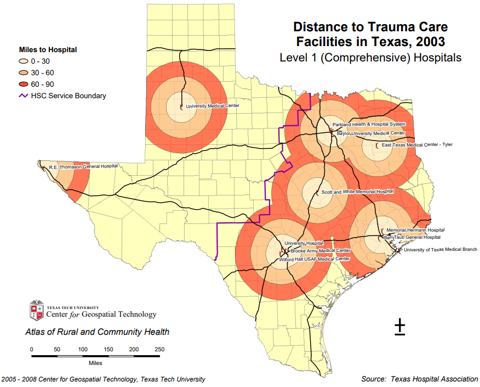HC-Trauma Hospital Access in Texas
A Stochastic Programming Model for Trauma Hospital Network Expansion considering Rural Communities and COVID-19
Goal: This project studies the design and expansion of the state of Texas trauma care system. The goal is to find the optimal geographic configuration of trauma care centers (TCCs) to maximize accessibility while promoting the efficient use of resources.
A two-stage stochastic programming model is derived to identify areas for the expansion of the trauma network.
Funded by: Texas Department of State Health Services (DSHS)
Principal Investigator: Dr. Eduardo Pérez
Collaborators:
- Dr. Francis Mendez Mediavilla (Texas State University),
- Texas Department of State Health Services
Graduate students:
- Alakshendra Joshi
- Sabhasachi Saha

Access to Trauma Level 1 hospitals in Texas
Data analysis-based optimization
- The first research aim looks at collecting and analyzing data on trauma incidents at different population regions in Texas (i.e. cities, suburban, and rural) to forecast service demands under multiple scenarios (i.e. accidents, industrial accidents., natural disaster)
- The second research aim is to model the Stochastic Trauma System Configuration Problem (STSCP). STFCP is to prescribe facility configuration including designation changes to existing facilities and the location and designation of new facilities.

Data analysis-based optimization
Research publications
Journal papers:
- Pérez, E., A. Joshi, S. Saha, and F.A. Méndez Mediavilla, (2025) “A Stochastic Programming Model for Trauma Hospital Network Expansion considering Rural Communities and COVID-19” Health Care Management Sciences - Accepted. (IF: 3.979).
- Joshi, A., E. Pérez, and F.A. Méndez Mediavilla, (2024) “An Empirical Analysis of Forecasting Methods for Trauma Injuries in Rural Areas – A Case Study” International Journal of Industrial and Systems Engineering, Vol.48, No.2, pp.278-300. DOI: 10.1504/ijise.2024.141597.
Conference proceedings:
- Streber, H., Streber, K., Van, M., Jimenez-Rivera, A., and E. Pérez, (2022) “Planning the Trauma Hospital Network Expansion to Increase Access in Rural Communities” Proceedings of the IISE Conference 2022, Seattle WA, May 20-23.